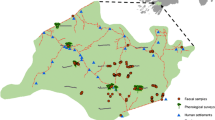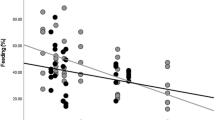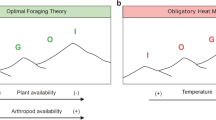Abstract
I studied insect-foraging strategies of great apes and aimed to define niche differentiation in their insect diet. I investigated seasonality in fruit-, foliage-, insect-, and meat-eating by great apes in southeast Cameroon via indirect methods and measured activity and nest densities of insect prey. I used a multinomial logistic regression to analyze the data. Gorilla and chimpanzee insect-, ant-, and termite-eating does not correlate with rainfall. Ant- and nonwinged termite-eating by chimpanzees increased in periods of succulent fruit scarcity and provided protein and energy, which might have compensated for the protein-low foliage eaten then. The apes ate winged termites when succulent fruit was abundant. Ant and winged termite consumption by gorillas correlates positively with that of chimpanzees. Ant-eating by gorillas increased when fruit was scarce, but was also associated with temporal ant activity and nest density. Both ape species also encountered more ant nests and trails in that period, as they predominantly foraged for herbs in vegetation types with high ant availability. In contrast, fruit-eating correlates positively with nonwinged termite-eating by gorillas, but again temporal prey availability is also associated. Termites might have provided 1) supplemental iron when tannin-rich fruits were eaten or 2) antidiarrheal properties when gorillas ate too much laxative fruit. Termite-eating by both ape species is not associated with spatial termite availability. In conclusion, there is niche differentiation in their insect diet. Based on the trade-off between foraging effort and nutritional gain, chimpanzees use a high-energy and gorillas a low-energy strategy when feeding on termites, but both use a low-energy strategy when feeding on ants. However, more information on the consumption of ant larvae is necessary to define niche differentiation in their ant diet.




Similar content being viewed by others
References
Boesch, C., & Boesch, H. (1990). Tool use and tool making in wild chimpanzees. Folia Primatologica, 54, 86–99. doi:10.1159/000156428.
Bogart, S. L., & Pruetz, J. D. (2008). Ecological context of savanna chimpanzee (Pan troglodytes verus) termite fishing at Fongoli, Senegal. American Journal of Primatology, 70, 1–8. doi:10.1002/ajp.20530.
Buckland, S. T., Anderson, D. R., Burnham, K. P., & Laake, J. L. (1993). Distance Sampling: Estimating Abundance of Biological Populations. London: Chapman and Hall.
Cipolletta, C., Spagnolietti, N., Todd, A., Robbins, M. M., Cohen, H., & Pacyna, S. (2007). Termite feeding by Gorilla gorilla gorilla at Bai Hokou, Central African Republic. International Journal of Primatology, 28, 457–476. doi:10.1007/s10764-007-9129-5.
Deblauwe, I., & Dekoninck, W. (2007). Diversity and distribution of ground-dwelling ants in a lowland rainforest in southeast Cameroon. Insectes Sociaux, 54, 334–342. doi:10.1007/s00040-007-0951-8.
Deblauwe, I., & Janssens, G. P. J. (2008). New insights in insect prey choice by chimpanzees and gorillas in southeast Cameroon: The role of nutritional value. American Journal of Physical Anthropology, 135, 42–55. doi:10.1002/ajpa.20703.
Deblauwe, I., Dupain, J., Nguenang, G. M., Werdenich, D., & Van Elsacker, L. (2003). Insectivory by Gorilla gorilla gorilla in southeast Cameroon. International Journal of Primatology, 24, 493–502. doi:10.1023/A:1023732212408.
Deblauwe, I., Guislain, P., Dupain, J., & Van Elsacker, L. (2006). Use of a tool-set by Pan troglodytes troglodytes to obtain termites (Macrotermes) in the periphery of the Dja Biosphere Reserve, Southeast Cameroon. American Journal of Primatology, 68, 1191–1196. doi:10.1002/ajp.20318.
Devanesen, D. (2000). Traditional Aboriginal medicine practice in the Northern Territory. International Symposium on Traditional Medicine. Awaji Island, Japan: World Health Organization.
Doran, D. M., McNeilage, A., Greer, D., Bocian, C., Mehlman, P., & Shah, N. (2002). Western lowland gorilla diet and resource availability: New evidence, cross-site comparisons, and reflections on indirect sampling methods. American Journal of Primatology, 58, 91–116. doi:10.1002/ajp.10053.
Doran-Sheehy, D. M., Greer, D., Mongo, P., & Schwindt, D. (2004). Impact of ecological and social factors on ranging in western gorillas. American Journal of Primatology, 64, 207–222. doi:10.1002/ajp.20075.
Ganas, J., & Robbins, M. M. (2004). Intrapopulation differences in ant eating in the mountain gorillas of Bwindi Impenetrable National Park, Uganda. Primates, 45, 275–278. doi:10.1007/s10329-004-0089-5.
Goldsmith, M. L. (1999). Ecological constraints on the foraging effort of western gorillas (Gorilla gorilla gorilla) at Bai Hokou, Central African Republic. International Journal of Primatology, 20, 1–23. doi:10.1023/A:1020528115829.
Guislain, P., & Dupain, J. (2005). Sudden great ape die-off in the periphery of the Dja Biosphere Reserve. Gorilla Journal, 30, 28–30.
Guislain, P., & Dupain, J. (2007). Determinants of Habitat Use by Sympatric Chimpanzee and Gorilla Populations at the Periphery of the Dja Faunal Reserve, Cameroon (Report). The Leaky Foundation, San Francisco.
Hashimoto, C., Suzuki, S., Takenoshita, Y., Yamagiwa, J., Basabose, A. K., & Furuichi, T. (2003). How fruit abundance affects the chimpanzee party size: Comparison between four study sites. Primates, 44, 77–81.
Hladik, C. M. (1977). Chimpanzees of Gabon and chimpanzees of Gombe: Some comparative data on the diet. In T. H. Clutton-Brock (Ed.), Primate Ecology: Studies of Feeding and Ranging Behaviour in Lemurs, Monkeys and Apes (pp. 481–501). London: Academic Press.
Jones, D. T., & Eggleton, P. (2000). Sampling termite assemblages in tropical forests: Testing a rapid biodiversity assessment protocol. Journal of Applied Ecology, 37, 191–203. doi:10.1046/j.1365-2664.2000.00464.x.
Kuroda, S., Nishihara, T., Suzuki, S., & Oko, R. A. (1996). Sympatric chimpanzees and gorillas in the Ndoki Forest, Congo. In W. C. McGrew, L. F. Marchant, & T. Nishida (Eds.), Great Ape Societies (pp. 71–81). Cambridge, UK: Cambridge University Press.
Letouzey, R. (1985). Notice de la carte phytogéographique du Cameroun au 1:500000. Institut de la Carte Internationale de la Végétation, Toulouse.
McGrew, W. C. (2001). The other faunivory: Primate insectivory and early human diet. In C. B. Stanford, & H. T. Bunn (Eds.), Meat-eating and Human Evolution (pp. 160–178). Oxford: Oxford University Press.
McGrew, W. C., Tutin, C. E. G., & Baldwin, P. J. (1979). Chimpanzees, tools, and termites: Cross-cultural comparisons of Senegal, Tanzania and Rio Muni. Man, 14, 185–214. doi:10.2307/2801563.
Milton, K. (1999). Nutritional characteristics of wild primate foods: Do the diets of our closest living relatives have lessons for us? Nutrition (Burbank, Los Angeles County, Calif.), 15, 488–498. doi:10.1016/S0899-9007(99)00078-7.
Milton, K. (2003). Micronutrient intakes of wild primates: Are humans different? Comparative Biochemistry and Physiology. A. Comparative Physiology, 136, 47–59.
Muroyama, Y. (1991). Chimpanzees’ choices of prey between two sympatric species of Macrotermes in the Campo Animal Reserve, Cameroon. Human Evolution, 6, 143–151. doi:10.1007/BF02435614.
Nguenang, G. M., & Dupain, J. (2002). Typologie et description morpho-structurale de la mosaïque forestière du Dja: Cas du site d’étude sur la socio-écologie des grands singes dans les villages Malen V, Doumo Pierre et Mimpala (Est-Cameroun) (Report). RZSA, Antwerp.
PAP, Protected Areas Program. (2001). World Heritage Sites, Cameroon, Dja Faunal Reserve. http://www.wcmc.org.uk/protected_areas/data/wh/dja.html.
Plumptre, A. J. (2000). Monitoring mammal populations with line transect techniques in African forests. Journal of Applied Ecology, 37, 356–368. doi:10.1046/j.1365-2664.2000.00499.x.
Plumptre, A. J., & Reynolds, V. (1996). Censusing chimpanzees in the Budongo forest, Uganda. International Journal of Primatology, 17, 85–99. doi:10.1007/BF02696160.
Putz, F. E. (1993). On diarrhea. Bulletin of the Ecological Society of America, 74, 177.
Remis, M. J. (1997). Western lowland gorillas (Gorilla gorilla gorilla) as seasonal frugivores: use of variable resources. American Journal of Primatology, 43, 87–109. doi:10.1002/(SICI)1098-2345(1997)43:2<87::AID-AJP1>3.0.CO;2-T.
Remis, M. J., Dierenfeld, E. S., Mowry, C. B., & Carroll, R. W. (2001). Nutritional aspects of western lowland gorilla (Gorilla gorilla gorilla) diet during seasons of fruit scarcity at Bai Hokou, Central African Republic. International Journal of Primatology, 22, 807–836. doi:10.1023/A:1012021617737.
Rogers, M. E., Williamson, E. A., Tutin, C. E. G., & Fernandez, M. (1988). Effects of the dry season on gorilla diet in Gabon. Primate Report, 22, 25–33.
Rogers, M. E., Maisels, F., Williamson, E. A., Tutin, C. E. G., & Fernandez, M. (1992). Nutritional aspects of gorilla food choice in the Lopé Reserve, Gabon. In N. Itoigawa, Y. Sugiyama, G. P. Sackett, & R. K. R. Thompson (Eds.), Topics in Primatology: Behavior, Ecology and Conservation, Vol. 2 (pp. 267–281). Tokyo: University of Tokyo Press.
Rogers, M. E., Abernethy, K., Bermejo, M., Cipolletta, C., Doran, D., McFarland, K., et al. (2004). Western gorilla diet: A synthesis from six sites. American Journal of Primatology, 64, 173–192. doi:10.1002/ajp.20071.
Sanz, C., Morgan, D., & Gulick, S. (2004). New insights into chimpanzees, tools, and termites from the Congo Basin. American Naturalist, 164, 567–581. doi:10.1086/424803.
Savini, T., Leus, K., & Van Elsacker, L. (2000). Effects of dietary changes on the behaviour and fecal consistency of three captive eastern lowland gorillas (Gorilla gorilla graueri) at the Royal Zoological Society of Antwerp. In J. Nijboer, J.-M. Hatt, W. Kaumanns, A. Beijnen, & U. Ganslosser (Eds.), Zoo Animal Nutrition (pp. 139–152). Fürth: Filander Verlag.
Schaller, G. B. (1963). The Mountain Gorilla: Ecology and Behaviour. Chicago: University of Chicago Press.
Schöning, C., Humle, T., Möbius, Y., & McGrew, W. C. (2008). The nature of culture: Technological variation in chimpanzee predation on army ants revisited. Journal of Human Evolution, 55, 48–59. doi:10.1016/j.jhevol.2007.12.002.
Suzuki, S., Kuroda, S., & Nishihara, T. (1995). Tool-set for termite-fishing by chimpanzees in the Ndoki forest, Congo. Behaviour, 132, 219–234. doi:10.1163/156853995X00711.
Tane, P., Tatsimo, S. D., Ayimele, G. A., & Connolly, J. D. (2006). Bioactive metabolites from Aframomum species. In: J. O. Midiwo, A. Yenesew & S. Derese (eds.), Proceedings of the 11th NAPRECA Symposium. Antananarivo, Madagascar, 2005, pp. 214–223
Thomas, L., Laake, J. L., Strindberg, S., Marques, F. F. C., Buckland, S. T., Borchers, D. L., Anderson, D. R., Burnham, K. P., Hedley, S. L., Pollard, J. H., & Bishop, J. R. B. (2003). Distance 4.1. Release “x”1. Research Unit for Wildlife Population Assessment. UK: University of St. Andrews http://www.ruwpa.st-and.ac.uk/distance/.
Tutin, C. E. G., & Fernandez, M. (1983). Gorillas feeding on termites in Gabon, West Africa. Journal of Mammalogy, 64, 511–513. doi:10.2307/1380376.
Tutin, C. E. G., & Fernandez, M. (1992). Insect-eating by sympatric lowland gorillas (Gorilla gorilla gorilla) and chimpanzees (Pan troglodytes troglodytes) in the Lopé Reserve, Gabon. American Journal of Primatology, 28, 29–40. doi:10.1002/ajp.1350280103.
Tutin, C. E. G., & Fernandez, M. (1993). Fecal analysis as a method of describing diets of apes: Examples from sympatric gorillas and chimpanzees at Lopé, Gabon. Tropics, 2, 189–197.
White, L. J. T., Rogers, M. E., Tutin, C. E. G., Williamson, E. A., & Fernandez, M. (1995). Herbaceous vegetation in different forest types in the Lopé Reserve, Gabon: Implications for keystone food availability. African Journal of Ecology, 33, 124–141. doi:10.1111/j.1365-2028.1995.tb00788.x.
Wood, T. G., Johnson, R. A., Bacchus, S., Shittu, M. O., & Anderson, J. M. (1982). Abundance and distribution of termites (Isoptera) in a riparian forest in the southern Guinea savanna vegetation zone Nigeria. Biotropica, 14, 25–39. doi:10.2307/2387757.
Yamagiwa, J., & Basabose, A. K. (2006). Diet and seasonal changes in sympatric gorillas and chimpanzees at Kahuzi-Biega National Park. Primates, 47, 74–90. doi:10.1007/s10329-005-0147-7.
Yamagiwa, J., Maruhashi, T., Yumoto, T., & Mwanza, N. (1996). Dietary and ranging overlap in sympatric gorillas and chimpanzees in Kahuzi-Biega National Park, Zaïre. In W. C. McGrew, L. F. Marchant, & T. Nishida (Eds.),Great Ape Societies (pp. 82–98). Cambridge, UK: Cambridge University Press.
Acknowledgments
I thank the RZSA, Durell Wildlife Conservation Fund, the logging company FIPCAM, MINRESI (Ministère de la Recherche Scientifique et de l’Innovation, Cameroon), MINFoF (Ministère de Forêt et de la Faune, Cameroon), and the Service de Conservation de la Reserve de Faune du Dja for supporting this project. I thank the Badjoué trackers who guided me and Patrick Guislain and the many volunteers who helped with data collection. The King Leopold III fund for Nature Exploration and Conservation (RBINS), the Flemish Inter-University Council (VLIR), Father Louis Bruyns Foundation (UA), and the Fund to Promote Scientific Research in Africa (NBG, Meisse) funded the fieldwork. I was supported by a grant from the UA and the RZSA. I thank the Flemish government for structural support to the CRC of the RZSA. Thanks are also due to Stefan Van Dongen for statistical advice; to Eric Arnhem for helping me with DISTANCE 4.1.; and to Nikki Tagg, Linda Van Elsacker, Jeroen Stevens, Patrick Guislain, David Watts, and an anonymous reviewer for helpful comments on the manuscript.
Author information
Authors and Affiliations
Corresponding author
Rights and permissions
About this article
Cite this article
Deblauwe, I. Temporal Variation in Insect-eating by Chimpanzees and Gorillas in Southeast Cameroon: Extension of Niche Differentiation. Int J Primatol 30, 229–252 (2009). https://doi.org/10.1007/s10764-009-9337-2
Received:
Accepted:
Published:
Issue Date:
DOI: https://doi.org/10.1007/s10764-009-9337-2




